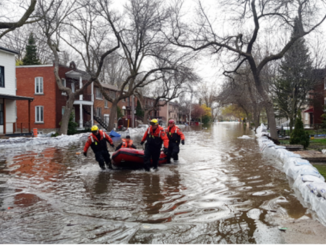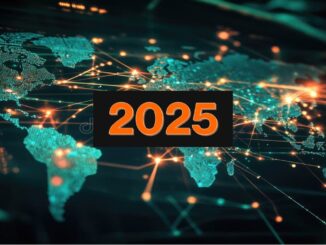This is the second part of the interview GoGeomatics Canada has done with Neil Thompson, the Managing partner of the WCGroup. Neil is also the former Director Geospatial Intelligence for the Canadian Forces and a retired Colonel. You can have a look at the first part of his interview here.
We are now going to engage in a broader discussion of GEOINT and its new wider use outside of military applications.
 GoGeomatics: What was the impact of digital imagery on GEOINT?
GoGeomatics: What was the impact of digital imagery on GEOINT?
Neil Thompson: Before we had digital imagery there was no Geospatial Intelligence (GEOINT). Sometimes we would overlay an image on a “map” with some annotations. When digital imagery became the norm, and then with the advent of smart phone and exact locational data became the norm Geo Int became possible.
GoGeomatics: How would you define GEOINT?
Neil Thompson: The current definition that we use is that, Geospatial Intelligence is derived from remotely and human sensed data, physical geography, land cover and cultural data. Geospatial Intelligence provides: foundation, multi-source intelligence and fused data.
GoGeomatics: How has GEOINT expanded outside of the military?
Neil Thompson: One current example outside of the military is the growing importance of the entire spectrum of critical infrastructures, their protection and the rapid pace that any damage must be mitigated and repaired, and this has dramatically increased demand for Situational Awareness. Geospatial Intelligence is the vital foundation for the process. No longer is it just products and services that are required, but decision makers demand knowledge.
The devastating floods in southern Alberta are the most recent example of how Geospatial Intelligence can be used to develop a community’s emergency response plan by identifying the location of schools, medical centers, staging areas, evacuation routes, and transportation choke points near bridges or overpasses. During an emergency, Geospatial Intelligence can be used to route response vehicles and quickly identify critical infrastructures such as water storage/treatment facilities, communication networks, electric generation facilities, and refineries. The rapid provision of Situational Awareness can only be provided if an effective Mission Management System is in place before any emergency and it is exercised regularly.
GoGeomatics: Situational awareness is built in large part on knowing quite a lot about the geography in relation to any given situation. Be it military or disaster. How is GEOINT involved in this context?
Neil Thompson: The importance of Geospatial Intelligence as the foundation for Situational Awareness continues to grow. Whether the use is emergency planning, response or mitigation, an effective Geospatial Intelligence Mission Management System can greatly enhance all phases of planning and consequence management. Geospatial Intelligence spans all facets of human endeavour: national security, civil Infrastructure, local government, natural resources and disasters, climate change, military operations, and counter terrorism operations. By applying the lessons learned and concepts developed by the military, the entire situational awareness process for critical Infrastructures operations will be enhanced.
As more fine grain information is gathered, data sets of all types can be developed to support the planning phase of critical infrastructures and consequence management operations. The Geospatial Intelligence community has rapidly moved towards a more “joined up” Geospatial Intelligence enterprise approach. When we accelerate the pace of using all types of imagery and data (space based, all types of air breathing, UAS, handheld, crowd sourcing, social media and other open source Geospatial Intelligence decision makers can gain the necessary knowledge faster and more accurately).
 GoGeomatics: How is a system for GEOINT actually put together and delivered?
GoGeomatics: How is a system for GEOINT actually put together and delivered?
Neil Thompson: To ensure that all the products are received by the customers in a timely manner, a Geospatial Intelligence Mission Management system is vital. All aspects of the GEOINT enterprise must be organized and operated effectively. This Mission Management system includes: the identification and verification of requirements, understanding all the collection system that are available and how to task each to use their strengths in the most effective manner. The analysis must be then be tasked, data stored and retrieved, and products then produced and disseminated.
GoGeomatics: What has changed in terms of methods and analysis within the GEOINT today? Is there anything you are particularly interested in that is moving forward?
Neil Thompson: One of the many changes is how rapidly and precisely geo-referenced geospatial intelligence can be collected, analyzed and displayed for everyone from the most senior policy maker to the soldier or first responder. This ensures that all the decision makers have the same accurate and timely data. With this shared situational awareness, all human activities are more effective and accountable.
Military and national security operations have always required Geospatial Intelligence; the elements of Geospatial Intelligence are:
• detailed knowledge of the environment including sea, land and air
• mapping and charting
• imagery including handheld, open source including crowd sourcing
• air breathing and space based
• safety of navigation
• change Factors-Policy and Security
• increased political and legal governance
• data quality, liability issues, intellectual property, data pedigree, formats, ownership, national security, police and reverse social media geospatial intelligence (crowd-sourcing/OSINT)
• intelligence customers are moving away from the imagery based products to output-value added visualization and knowledge
• must support 24/7 tempo, decision makers will “shop” for data if we do not provide
• security issues,
GoGeomatics: Any other driving forces?
Neil Thompson: The other driving force is the requirement to reduce collateral damage. For military operations the accuracy of today’s precision weapons systems and the proliferation of surveillance and armed Unmanned Aerial Vehicles (UAV) demand that there is a new generation of dynamic geospatial intelligence products and services.
While the demand for accurate and timeliness continue to increase, the human dimension has also become more challenging. The new generation of geospatial specialists must be highly trained, clearly understand the requirements and be accurate. The skills and work flows of the more deliberate geospatial analyst and those of the time dominate analyst must be merged.
For many years one of the main challenges was the availability and geospatially accurate imagery from which the full spectrum of Geospatial Intelligence products and services could be produced. These restrictions have evaporated with the availability of new and very capable radar and electro-optic imagery. The current challenges now are more time, space and resource based. The following are some of the challenges:
• majority of remote sensing data is purchased by governments
• most governments are reducing resources
• time consuming for customers to search the various websites for data sources
• cost of storing massive amounts of imagery
• timeliness of some types of imagery to support maritime surveillance
• high cost of remote sensing data
 GoGeomatics: We have talked previously about social media and GEOINT. Can you explain more about how it’s starting to factor into the Militaries use of data sourced from this channel and crowd sourced data in general?
GoGeomatics: We have talked previously about social media and GEOINT. Can you explain more about how it’s starting to factor into the Militaries use of data sourced from this channel and crowd sourced data in general?
Neil Thompson: One of the areas that are of real interest is that the role of social media is an example of how GEOINT has developed and matured. The Intelligence community always used Open Source Intelligence (OSINT) data. There were many sources of this data and it was key to understanding many complex intelligence problems. As GEOINT developed, the GIS community understood the importance of ‘crowd sourcing” and the GEOINT social media. This is now become to be known as GEOINT OSINT. It is vital for many intelligence and GEOINT problems. The same challenges of any sources still remain but the sheer volume and Geo spatial accuracy makes it even more important that in the past.
Another area that has moved from the Intelligence community to the GEOINT world is that of Human Terrain Analysis (HTA). It may be the new buzzword, but in fact, the analysis of where people live, how are they organized (tribes, families and groups), their economy and how they interact with each other has been of vital interest for a thousand years.
GoGeomatics: Why is it important to collect this data?
Neil Thompson: The reason to collect this data is to assess how these groups will possibly react to any outside influence such as exploration, natural resource extraction, infrastructure improvements or military operations.
Traditionally, the geospatial and intelligence communities were conducting human terrain analysis for different, but complimentary, purposes. The Intelligence community wanted the macro level Human Geograph; the large scale location of tribes, and the historic trends produced by the geospatial communities. The intelligence analysis then took this and gathered more data to develop a micro level picture.
As more fine grain information is gathered, data sets such as family, extended family, tribe and compound products can be developed. This can be used for a variety of customers, such as where to build schools or water purifications plants. In addition, it can be used as part of the targeting process.”
GoGeomatics: Neil thank you very much for taking the time to discuss GEOINT with us.
–
Neil Thompson OMM CD, [email protected] Managing Partner, Westfield Consulting Group (www.wcgroup.ca )





Be the first to comment